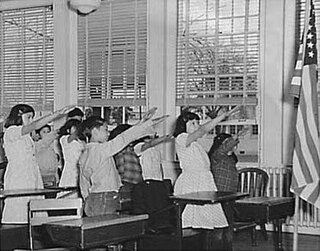 W
WA salute is a gesture or other action used to display respect. When saluting a person, as distinct from a flag or a national anthem or other symbolic melody, the gaze must be towards that person, also when returning a salute. Thus, the respectable salute includes a greeting. Not looking at the person, as with most gestured greetings, is likely to be interpreted as disrespectful or an eye deficiency. Salutes are primarily associated with armed forces and law enforcement, but other organizations, such as girl guides, scouts and other civilians also use salutes.
 W
WA 21-gun salute is the most commonly recognized of the customary gun salutes that are performed by the firing of cannons or artillery as a military honor. As naval customs evolved, 21 guns came to be fired for heads of state, or in exceptional circumstances for heads of government, with the number decreasing with the rank of the recipient of the honor. While the 21-gun salute is the most commonly recognized, the number of rounds fired in any given salute will vary depending on the conditions. Circumstances affecting these variations include the particular occasion and, in the case of military and state funerals, the branch of service, and rank of the person to whom honors are being rendered.
 W
WDuring their medal ceremony in the Olympic Stadium in Mexico City on October 16, 1968, two African-American athletes, Tommie Smith and John Carlos, each raised a black-gloved fist during the playing of the US national anthem, "The Star-Spangled Banner". While on the podium, Smith and Carlos, who had won gold and bronze medals respectively in the 200-meter running event of the 1968 Summer Olympics, turned to face the US flag and then kept their hands raised until the anthem had finished. In addition, Smith, Carlos, and Australian silver medalist Peter Norman all wore human-rights badges on their jackets.
 W
WThe Bellamy salute is a palm-out salute described by Francis Bellamy, the author of the American Pledge of Allegiance, as the gesture which was to accompany the pledge. During the period when it was used with the Pledge of Allegiance, it was sometimes known as the "flag salute". Both the Pledge and its salute originated in 1892. Later, during the 1920s and 1930s, Italian fascists and Nazi Germans adopted a salute which was very similar, erroneously attributed to the Roman salute, a gesture that was popularly believed to have been used in ancient Rome. This resulted in controversy over the use of the Bellamy salute in the United States. It was officially replaced by the hand-over-heart salute when Congress amended the Flag Code on December 22, 1942.
 W
WNamaste, sometimes spoken as namaskar and namaskaram, is a Hindu customary, non-contact form of respectfully greeting and honoring the opposite person or group, used at any time of day. Today, it is found on the Nepal and Indian subcontinent, Southeast Asia and among the Indian diaspora worldwide. The gesture is widely used as a greeting in the parts of Southeast Asia where Indian religions are strong. Namaste is usually spoken with a slight bow and hands pressed together, palms touching and fingers pointing upwards, thumbs close to the chest. This gesture is called añjali mudrā; the standing posture incorporating it is pranamasana.
 W
WThe Nazi salute, Hitler salute, or Sieg Heil salute, is a gesture that was used as a greeting in Nazi Germany. The salute is performed by extending the right arm from the neck into the air with a straightened hand. Usually, the person offering the salute would say "Heil Hitler!", "Heil, mein Führer!", or "Sieg Heil!". It was adopted in the 1930s by the Nazi Party to signal obedience to the party's leader, Adolf Hitler, and to glorify the German nation. The salute was mandatory for civilians but mostly optional for military personnel, who retained the traditional military salute until the failed assassination attempt on Hitler on 20 July 1944.
 W
WPraṇāma is a form of respectful or reverential salutation before something, or another person – usually grandparents, parents, elders, husband/wife, or teachers or someone deeply respected such as a deity, found in Indian culture and Hindu traditions.
 W
WThe Roman salute or fascist salute is a gesture in which the arm is fully extended, facing forward, with palm down and fingers touching. In some versions, the arm is raised upward at an angle; in others, it is held out parallel to the ground. In contemporary times, the former is widely considered a symbol of fascism based on a custom popularly attributed to ancient Rome. However, no Roman text gives this description, and the Roman works of art that display salutational gestures bear little resemblance to the modern Roman salute.
 W
WThe Saluting Battery is an artillery battery in Valletta, Malta. It was constructed in the 16th century by the Order of Saint John, on or near the site of an Ottoman battery from the Great Siege of Malta. The battery forms the lower tier of St. Peter & Paul Bastion of the Valletta Land Front, located below the Upper Barrakka Gardens and overlooking Fort St. Angelo and the rest of the Grand Harbour.
 W
WThe Schwurhand is a heraldic charge depicting the hand gesture that is used in Germanic Europe and neighboring countries, when swearing an oath in court, in office or in swearing-in. The right hand is raised, with the index finger and middle finger extended upwards; the last two digits are curled downwards against the palm. The thumb is shown slightly curled or raised.
 W
WThe three-finger salute is used by members of Scout and Guide organizations around the world when greeting other Scouts and in respect of a national flag at ceremonies. In most situations, the salute is made with the right hand, palm face out, the thumb holding down the little finger, and with the fingertips on the brow of the head. There are some variations of the salute between national Scouting organizations and also within some programme sections.
 W
WA Ship's Salute is a gesture or other action used to display respect. Salutes are primarily associated with armed forces, but other organisations and civil people also use salutes. Such a salute in terms of maritime connotations, usually involves the entering into, or retirement from, service, of civilian or military personnel; a vessel, or aircraft.
 W
WThe three-finger salute, commonly known as the Serbian salute, is a salute which originally expressed the Holy Trinity, used in oath-taking, and a symbol of Serbian Orthodoxy, that today simply is an expression, a gesture, for ethnic Serbs and Serbia, made by extending the thumb, index, and middle fingers of one or both hands. The salute usually goes along with the Serbian flag, using several semantic layers to depict its historical meaning, while also being used a symbol of Serbian ethno-nationalism during the Guča Trumpet Festival.the salute remains a distinctive sign for the ethnic Serb and a symbol for belonging to the Serbian nation.
 W
WThe three-volley salute is a ceremonial act performed at military funerals and sometimes also police funerals. The custom originates from the European dynastic wars, in which the fighting ceased so that the dead and wounded could be removed. After this was accomplished, three shots were fired into the air to signal that the battle could resume.
 W
WThe Vulcan salutation is a hand gesture popularized by the 1960s television series Star Trek. It consists of a raised hand with the palm forward and the thumb extended, while the fingers are parted between the middle and ring finger.
 W
WA water salute occurs for ceremonial purposes when a vehicle travels under plumes of water expelled by one or more fire fighting vehicles.
 W
WThe Zogist salute, or the nationalist Albanian salute, is a military salute of Albania since used by civilians in other countries. The salute is a gesture whereby the right hand is placed over the heart, with the palm facing downwards.